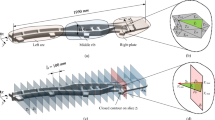Abstract
To this day, the design of preforms for hot forging processes is still a manual trial and error process and therefore time consuming. Furthermore, its quality vastly depends on the engineer’s experience. At the same time, the preform is the most influencing stage for the final forging result. To overcome the dependency on the engineer’s experience and time-consuming optimization processes this paper presents and evaluates a preform optimization by an algorithm for cross wedge rolled preforms. This algorithm takes the mass distribution of the final part, the preform volume, the shape complexity, the appearance of folds in the final part and the occurring amount of flash into account. This forms a multi-criteria optimization problem resulting in large search spaces. Therefore, an evolutionary algorithm is introduced. The developed algorithm is tested with the help of a connecting rod to estimate the influence of the algorithm parameters. It is found that the developed algorithm is capable of creating a suitable preform for the given criteria in less than a minute. Furthermore, two of the five given algorithm parameters, the selection pressure und the population size, have significant influence on the optimization duration and quality.











Similar content being viewed by others
References
Behrens B-A, Nickel R, Müller S (2009) Flashless precision forging of a two-cylinder crankshaft. Prod Eng 3(4-5):381–389. https://doi.org/10.1007/s11740-009-0185-x
Kache H, Stonis M, Behrens B-A (2012) Development of a warm cross wedge rolling process using FEA and downsized experimental trials. Prod Eng Res Devel 6(4-5):339–348. https://doi.org/10.1007/s11740-012-0379-5
Hatzenbichler T, Buchmayr B (2008) Vorformoptimierung für das Gesenkschmieden mittels numerischer Simulation. BHM Berg- und Hüttenmännische Monatshefte 153(11):413–417. https://doi.org/10.1007/s00501-008-0422-1
Shao Y, Lu B, Ou H, Ren F, Chen J (2014) Evolutionary forging preform design optimization using strain-based criterion. Int J Adv Manuf Technol 71(1-4):69–80. https://doi.org/10.1007/s00170-013-5456-1
Mirsaeidi M. et al. (2009) Optimum forging preform shape design by interpolation of boundary nodes. Proceedings of the world congress on Engineering Vol 2
Behrens B-A, Nickel R, Stonis M (2012) Simulation algorithm for the assessment and modification of multi-directional forging processes and tool gemoetries. Prod. Eng. Res. Devel. 6(2):187–198. https://doi.org/10.1007/s11740-012-0364-z
Landkammer P, Schneider T, Schulte R, Steinmann P, Merklein M (2016) A non-invasive form finding method with application to metal forming. Prod. Eng. Res. Devel. 10(1):93–102. https://doi.org/10.1007/s11740-016-0659-6
Behrens B-A, Stonis M, Rasche N (2018) Influence of the forming angle in cross wedge rolling on the multi-directional forging of crankshafts. Int J Mater Form 11(1):31–41. https://doi.org/10.1007/s12289-016-1326-3
Al-Zuheri A, Luong L, Xing K (2016) Developing a multi-objective genetic optimisation approach for an operational design of a manual mixed-model assembly line with walking workers. J Intell Manuf 27(5):1049. https://doi.org/10.1007/s10845-014-0934-3
Zhou G, Ma ZD, Cheng A, Li G, Huang J (2015) Design optimization of a runflat structure based on multi-objective genetic algorithm. Struct Multidisc Optim 51(6):1363. https://doi.org/10.1007/s00158-014-1217-5
Fu Y, Yang R, Yeh I (2004) A genetic algorithm for optimal design of an inflatable knee bolster. Struct Multidisc Optim 26(3-4):264. https://doi.org/10.1007/s00158-003-0344-1
Richter J, Blohm T, Langner J, Stonis M, Behrens B-A (2017) Quality optimization for aluminum precision forging processes in completely enclosed dies of long forging parts by prediction and avoidance of thin flash generation. Procedia Engineering 207:484–489. https://doi.org/10.1016/j.proeng.2017.10.809
Richter J, Stonis M, Langner J, Blohm T, Behrens BA (2018) Development of a predictive simulation method for thin flash generation in flashless precision forging processes of aluminum parts using FEA and experiments. Prod Eng Res Devel 12(3-4):1–11. https://doi.org/10.1007/s11740-018-0803-6
Goldberg D (1989) Genetic algorithms in search, optimization and machine learning. Addison-Wesley, London
Haupt RL, Haupt SE (2004) Practical genetic algorithms. Wiley, Hoboken
Behrens B-A et al (2007) Untersuchungen zur numerischen Ermittlung von Schmiedefalten. In: UTF Science, Jg., H. 2, S. In: 1–6
Knust J, Stonis M, Behrens B-A (2016) Preform optimization for hot forging processes using an adaptive amount of flash based on the cross section shape complexity. Prod. Eng. Res. Devel. 10(6):587. https://doi.org/10.1007/s11740-016-0702-7
Knust J, Podszus F, Stonis M, Behrens BA, Overmeyer L, Ullmann G (2017) Preform optimization for hot forging processes using genetic algorithms. Int J Adv Manuf Technol 89(5-8):1623. https://doi.org/10.1007/s00170-016-9209-9
Acknowledgements
The authors thank the German Research Foundation (Deutsche Forschungsgemeinschaft) for the funding of the research project “Entwurf optimaler Vorformstufen zum Herstellen von Schmiedebauteilen unter Anwendung von stochastischen Optimierungsverfahren” (DFG BE 1691/177-1 and DFG OV 36/22-1). The authors thank the Hammerwerk Fridingen GmbH for the support in this project. The authors declare that they have no conflict of interest.
Author information
Authors and Affiliations
Corresponding author
Additional information
Publisher’s Note
Springer Nature remains neutral with regard to jurisdictional claims in published maps and institutional affiliations.
Rights and permissions
About this article
Cite this article
Kampen, D., Richter, J., Blohm, T. et al. Design of a genetic algorithm to preform optimization for hot forging processes. Int J Mater Form 13, 77–89 (2020). https://doi.org/10.1007/s12289-019-01469-4
Received:
Accepted:
Published:
Issue Date:
DOI: https://doi.org/10.1007/s12289-019-01469-4




